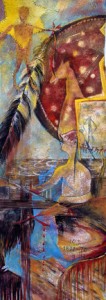To and From Crazy Horse
 “To and From Crazy Horse” 11 x 30” Watercolor and Gouache on Paper
“To and From Crazy Horse” 11 x 30” Watercolor and Gouache on Paper
Crazy Horse, a powerful Sioux chief, unified the Sioux and Cheyenne tribes to resist the United States Government. The era in which he lived and fought were called the Indian Wars.
Along with steady encroachments on Native American land, the Indians were killed with bullets as well as disease. Reservations were set aside upon which the Native Americans were being forced to relocate. The telling of this war, as in any war, depends on the teller. A record left by the Native Americans is called a Winter Count. A significant event from each year was recorded on various tribes’ winter counts. According to the Battiste Good Winter Count, 1874 was called “Measles and Other Sickness Used Up the People Winter.” This was the year Crazy Horse lost his daughter to illness.
As seen in a vision, Crazy Horse seemingly could not be touched by bullets in battle. His ability to unite the people led to General Custer’s defeat at the Battle of the Little Big Horn in 1876. The Flame Winter count recorded this year as “Horses taken by the U. S. Government”, as the Native Americans who peacefully relocated to the reservation, had their horses taken away.
1877 brought about the beginning of the end for life on the plains. Drought, war, and the annihilation of the bison were making it impossible for a tribe to survive off of the reservation. For the good of his people, Crazy Horse turned himself in. Crazy Horse was killed: not by enemy bullet, but by being bayoneted by the Indian police at Fort Robinson. The death of Crazy Horse allowed the U.S, Government to relocate the Sioux without further unified resistance.
The story: the HISTORY is compelling and a big part of the American story that constitutes the American I live in today.